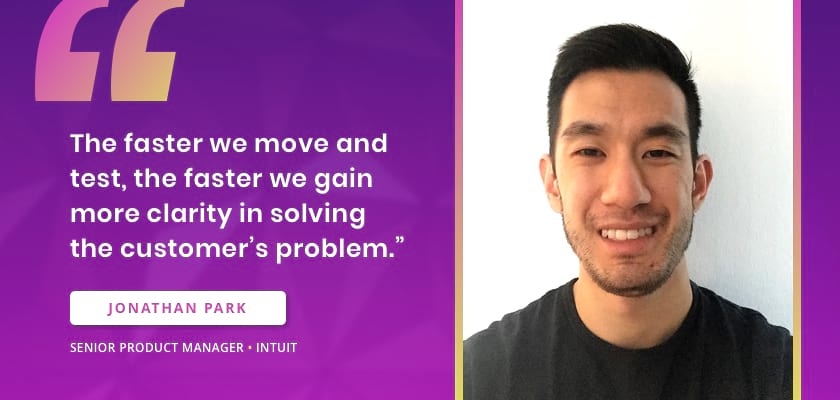PM Spotlight: How Designing for Delight Helps Intuit Lead Product Development

We caught up with Jonathan Park, a Senior Product Manager at Intuit who joined the team and completed his onboarding remotely. Among his responsibilities, Jonathan oversees the Mint personal finance and budgeting app for the Canadian market, helping users better understand and manage their finances.
He shares strategies on how listening to your users and gaining cross functional alignment are key to building products that your users will love. Enjoy!
Being an effective Product Manager requires working with people in various departments and levels of an organization. If cross-functional collaboration wasn’t already hard enough in-person, product management in a fully virtual setting has its own unique set of challenges. Starting at a new role can be challenging, especially when you’re onboarding virtually. How did you approach this?
As a PM, who is delivering a product in an adjacent market, it was crucial to deeply understand Mint’s product strategy in its primary market before determining what the strategy should be for Canada. After that, the next steps involved building our strategy for the next fiscal year, ensuring we were aligning to the broader org’s vision and getting the necessary buy-in internally which can be a challenge – especially when being new to a role.
For the first few months, I focused primarily on building relationships. Building relationships in product management is key because you don’t have anyone directly reporting to you, yet you rely on everyone else for you to be successful. Along with getting to know people across the organization, I had to learn how Intuit worked as a whole so I could understand how I fit into the broader global org.

At Intuit there’s a focus to “Design For Delight”. Can you explain what this means?
Design For Delight (or D4D) is Intuit’s way of developing deep empathy with our customers, and increasing confidence that we’re designing something our customers really want and need. A common exercise at Intuit is that PM’s will conduct “Follow Me Homes”, where we shadow customers in their homes completing a specific task. An example would be watching customers filing their taxes while not saying or directing anything, but simply observing.
Based on this, we understand how customers truly interact with our product. We notice the setting the customer is in, what they do before and after their task, as well as any distractions they faced during the process. By meeting them where they are, we can uncover pain points and challenges that you wouldn’t find by asking them interview questions or conducting a usability test. Not to say we don’t use other forms of customer research, which we do (especially during current times), but Follow Me Home is the most authentic way to observe and understand your customer’s behaviours.
Based on the findings from shadowing our customer, we then come up with a list of validated problems and create hypotheses on solutions that we believe will solve the pain points observed in the Follow Me Homes. This process, as well as simply talking to our customers on a regular basis, is deeply embedded in the product process and is a catalyst to driving product innovations that are grounded in customer empathy.
Once we’ve built and aligned on a hypothesis, we try to find out how to test them in the most lean way possible. Taplytics is a great tool to help you do this.
Teams build out experiments that can be created in days rather than weeks so we get data back immediately. Once we feel like we have enough validation from the tests and that it solves the problem the customer was facing, we then go ahead and build the feature and scale it to more customers.
There are big risks in big releases, but small rollouts are easy to rollback and come with less risk and cost to the team.
One of the main challenges of being a PM is getting alignment from stakeholders. What’s your strategy to ensure everyone’s onboard with an idea?
It’s crucial to gain alignment from the get-go. I do this by bringing stakeholders onboard from the beginning of the product discovery. This means communicating the findings and pain points from the user research so they agree that the problem is worth solving and the potential impact this can drive. Once everyone agrees on the prioritization of the problem, everything becomes easier moving forward.
Another roadblock can be that stakeholders aren’t confident or are hesitant with the experiment we want to run because it hasn’t been fully flushed out or polished. I like to give assurance that once you roll something out and discover it doesn’t work, it’s very easy to roll it back and iterate. Pushing something out that we have 80% confidence in is better than not pushing anything at all until we have 100% confidence. There’s a huge cost of inaction as we don’t learn anything by staying still. An unvalidated hypothesis is just as good as a validated hypothesis as it helps us learn more about our customers and what they need or don’t need. The faster we move and test, the faster we gain more clarity in solving the customer’s problem. There are big risks in big releases, but small rollouts are easy to rollback and come with less risk and cost to the team.

What advice would you give to people who are looking to convince their leadership to adapt a more agile approach?
Put more emphasis on anchoring leadership on the bigger vision of what we’re looking to achieve, and regularly reminding them of the North Star goal.
Once leadership is crystal clear on the broader problem you want to solve for the customer, they can better tie back the small tests and incremental enhancements you want to implement that lead up to the bigger vision or problem. Storytelling is another important way to influence how you lead the team and convince others. Make sure you convey the message that small tests can help achieve long term goals.
Running experiments is about de-risking your team from pursuing a path that doesn’t have legs.
The hypothesis process is crucial in determining what tests will be done. Can you explain your strategy to developing hypotheses at Intuit?
There’s always an emphasis on collaboration throughout this process. This is done by the working team and key stakeholders. Based on the biggest validated customer problem the team has discovered, we brainstorm a wide array of solutions that we feel may deliver the ideal state for the customer. After prioritizing the solutions (one tactic could be via dot voting), we list our assumptions that would need to be proven true for the success of the idea, also known as ‘Leap of Faith Assumptions’. And we begin designing experiments for the assumptions that haven’t been validated which are also crucial for success.
It’s at this step where we develop our hypothesis around the experiment, capturing how we believe customers will behave and what will determine the experiment to be a success. The goal is to create experiments that can be built in a matter of days to test our hypothesis very quickly and scrappily. We want to invest as little time and cost as possible. A simple example would be if we wanted to test whether customers were interested in buying coffee mugs, we could throw up an image of a coffee mug with a short description, and a ‘Pre Order Now’ button leading to a sign-up form to test how many signups occurred, as opposed to setting up the supply chain, paying for inventory upfront, creating a full ecommerce site, and spending money on paid marketing with a massive launch only to find out nobody wants your coffee mugs. Running experiments is about de-risking your team from pursuing a path that doesn’t have legs.
Being in a role which requires so much collaboration, what are your best practices for starting as a PM remotely?
I always like to approach conversations with a curious mindset, and recommend leading with questions as opposed to advocacy. At the start, you’re faced with the challenge of having to ramp up quickly so that you can start leading and driving influence in what problems the team should be solving. And if you try to lead too quickly without a clear understanding of the lay of the land, or context behind the decisions that were made in the past, you run a risk of driving the team to a dead end, and damaging relationships and your reputation along the way.
So I focused less on the deliverables in the beginning and more on understanding everyone’s role in the organization, and how they help create impact for the customer and the business. It’s crucial to ask about how people like to work, and how they determine if something is a priority or not in order to peek into their preferences and thought process. You should also understand everyone’s perspectives on the current state of the product as well as the long term vision of how the product can grow, in order to leverage everyone’s unique insights and expertise into the overall product strategy.
I didn’t go into meetings trying to push a specific agenda, but rather focused on learning who they are, what they know, and what their unique superpowers are. I would suggest developing a solid relationship with your team and stakeholders and viewing it as a partnership rather than a transactional relationship. I can’t stress that enough.
What other recommendations do you have for other PM’s starting on a new team?
This may sound cheesy, but I truly value empathy whether that be with the customers so you can see what they’re going through, or with coworkers and the different partners you work with. I started my career as a PM going into meetings with a list of deliverables and only seeing people for how they can help me. Now I find myself leading based on seeking alignment, fostering open discussions, and being prepared to pivot if a better plan is on the table. Get to understand the people first, then get into the work.
Being on a new team virtually, it can be hard to connect with coworkers to build that chemistry to be more effective, so now more than ever building relationships can be a key to success not only as a PM, but in any role.
I also like to help aspiring Product Managers in their journey to land their next PM role. After personally going through many Product Manager interview processes over the years, I’ve gained valuable learnings and tips that I’m happy to share to those seeking direction in their PM journey. Feel free to connect on LinkedIn to chat with me.
____
Taplytics brings together digital customer journey design, optimization, and messaging—in a single application. Start your free trial today and see why brands like Grubhub, Chick-fil-A, and Major League Soccer choose Taplytics to upgrade their apps, websites, and consumer communication channels.
